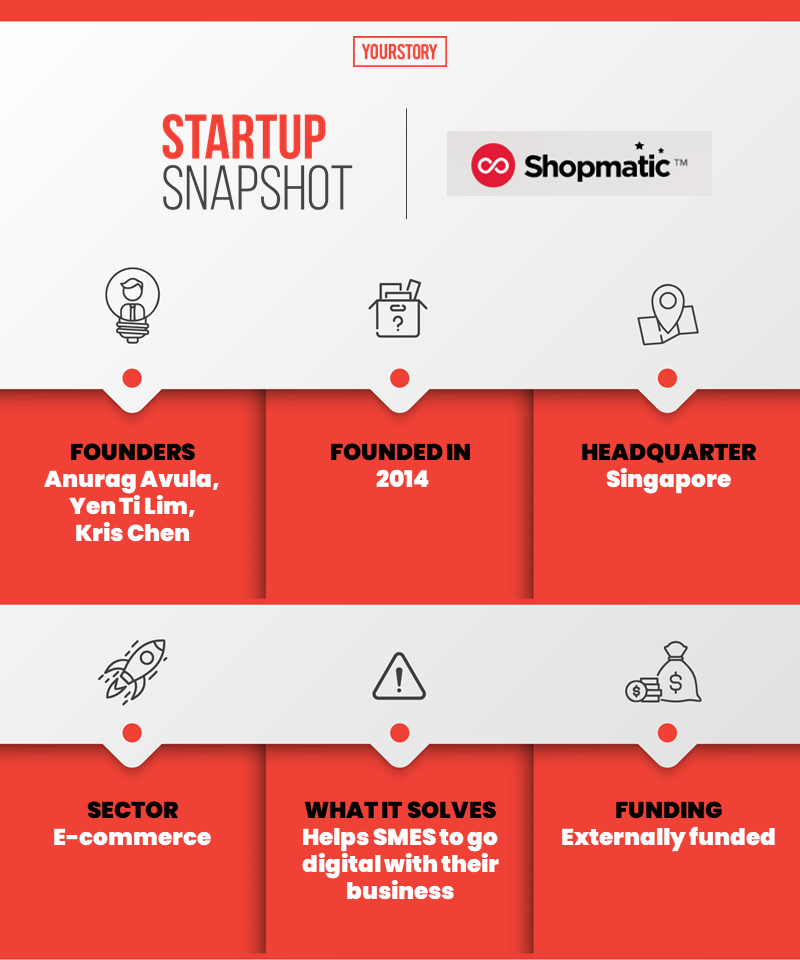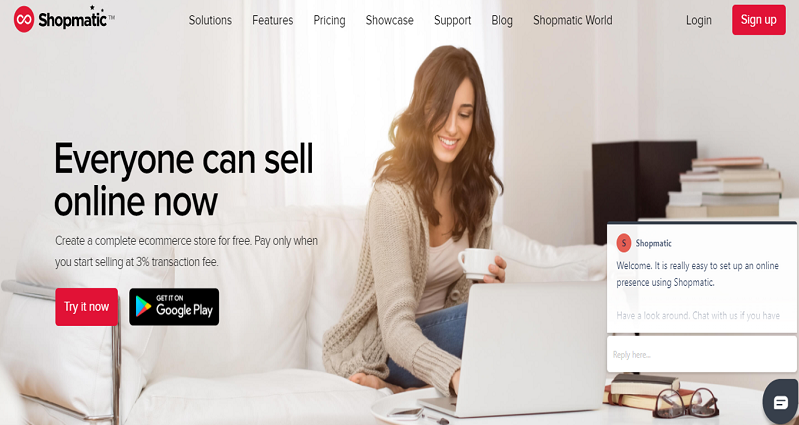The COVID-19 pandemic has forced most small businesses to re-evaluate their business models. While in-person and social setting was the norm earlier, the ongoing crisis forced them to come up with contactless method of delivering their products and services.
In this scenario, international ecommerce platform Shopmatic, which provides tech-enabled solutions for the SME sector, decided to tap into the opportunity.
The Singapore-based startup, which is completing five years in India this year, expanded its offering to create tailored solutions for Kirana stores, enabling them to create an online presence. It has enabled over 5 lakh SME merchants in Tier II, III, and IV markets to go digital.

Shopmatic founders Kris Chen, Anurag Avula, and Yen Ti Lim
From setting up a customised web store, managing payment gateway integration, fixing logistics and shipping support, handling digital promotions, and offering insights from big data analytics, the company has evolved to become an end-to-end service provider, enabling merchants to do business online.
Started by former PayPal employees Anurag Avula, Yen Ti Lim, and Kris Chen in 2014, Shopmatic has now grown to be a 120-member global team, with operations in India, Singapore, Malaysia, Hong Kong, and UAE, among others.
Riding on an upward trajectory with its tech-enabled solutions for the SME sector, Shopmatic claims to be EBITDA positive, and has seen 30 percent growth a year earlier than projected, and ended the April-June quarter with 200 percent growth in transactions, revenue, and GMV. It also registered revenues of over $5.5 million in the first half of 2020, surpassing its target by more than 190 percent.
From launching to adopting
Shopmatic entered the Indian market in October 2015 with a simple goal to help millions of aspiring entrepreneurs who are looking to take their business online. But the startup was faced with certain initial challenges like high capital expenses, complex solutions, and too many claims from different vendors.
“We felt there was a gap in the market, and we wanted to help these businesses by building solutions in a manner that works for them,” says CEO and Co-founder Anurag.
Over the years, the Singapore-based startup’s business model has evolved. From a subscription model earlier, today it follows a transaction pricing, which the company says has been a game changer.

“Earlier, we used to acquire 2,000 merchants in a month, and now we are able to acquire 800 merchants in a day,” says Anurag.
“However, one fundamental thing that remains unchanged is that we want to build a product that enables the entire ecosystem. This means that we could enable all our merchants who sell through an online store, through social commerce, conversational commerce, through marketplaces, and point of sale. We also provide payment, shipping, advertising, etc.,” he tells YourStory.
The startup considers all its partnerships and acquisitions - CombineSell and Octopus in 2019 - as one of the key turning points in its journey. With these acquisitions, Shopmatic is aimed at driving an omnichannel play for individual entrepreneurs and businesses in emerging markets by enabling the entire ecommerce and retail management ecosystems for them to succeed.
“The acquisitions we did brought the solutions together. We were able to fulfil the value proposition in that sense,” Anurag adds.
Reaching small towns
For the Shopmatic team, some of the earlier challenges was to try and find the right business formula. It realised that most merchants in the emerging markets want to take on a solution that will align to their success criteria as well.
Anurag says, “Ideally, most merchants want to see a value before they decide to pay for it. The transactional model removed the inertia of merchants wanting to try the solution because we have made the entry barrier low for merchants to come in and use the platform. They pay three percent of the amount received as the cost per transaction and another Rs 50 per month. But as the transactions ramp up, we also capped their cost. That was a big learning for us.”

Anurag Avula, Co-Founder & CEO, Shopmatic
Shopmatic, which was just a web-based product before, realised early that smartphone is the best way to penetrate the market. It soon started reaching merchants in Tier II, III, and IV markets via smartphones. Today, the startup has merchants from around 400 cities in India.
With COVID-19 coming in, going digital became not an option but a necessity for most people. This has helped Shopmatic in getting a transactional growth with people buying online.
“Our existing merchants have seen a lot of success. We saw an increase in the transactional fee as revenue as more and more merchants started using our platform. Our organic or non-paid acquisition of merchants was 10 percent. But during COVID, it went up to 35-40 percent. This means that our customer numbers have gone up,” Anurag explains.
Going digital
According to Anurag, most of the transactions in the emerging markets happens in social commerce, conversational commerce, and marketplaces - making it a primary driver of transactions.
“About 80 percent of the transactions are mobile driven, with buyers using phone for transactions. About 85 percent are social, chat, and marketplace driven in terms of ecommerce. We are starting to see the trend of video commerce/ live streaming, etc., taking off,” he says.
Adding to this is the rise in the usage of social media platforms such as Instagram, WhatsApp, and Facebook, which are all ecommerce driven now.

Screengrab of Shopmatic's web page
Though Shopmatic is sector agnostic, the COVID-19 pandemic gave rise many online grocery stores. Shopmatic thus expanded its offerings to create tailored solutions for India’s Kirana stores. This initiative enabled kirana stores to create an online presence with pre-developed catalogues for easier onboarding experience, following the company’s philosophy of not needing its customers to have technical know-how or design experience.
The platform also offered easy inventory management, secure and instant online payments, contactless delivery, and self-pickup options.
However, Anurag says, fashion and accessories merchants are the platform’s biggest category - followed by packaged F&B merchants and home décor.
Road ahead
The company witnessed 80 percent growth over the July-September quarter in transactions and GMV compared to the previous quarter, a testament to the digital wave, which has been accelerated due to the effects of COVID-19.
The team is now planning to expand to Africa and to the rest South East Asia and Middle East this year. It is also hoping to reach $100 million in revenue by 2024.
Edited by Megha Reddy
Link : https://yourstory.com/2020/11/ecommerce-startup-shopmatic-growth-sme-covid-19
Author :- Apurva P ( )
November 24, 2020 at 05:20AM
YourStory



